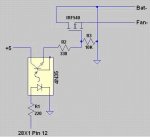I’m a newbie with this stuff and I need help. I’m trying to use a Picaxe 28X1 to drive a PWM switch. I’m using a small 12VDC fan as test load. I made this circuit on a solderless board (attached 1).
The Picaxe drives an opto (4N35), which drives an IFR540 from a regulated +5V supply. This circuit works perfectly and fan speed varies with duty cycle. (I know there should be a back emf diode from Fan- and Bat-, but I'm only using the Fan as test load and don’t expect much back emf in the final setup).
When I try to graduate from the solderless board to one where 4 MOSFETs are soldered in parallel as a separate PWM switch (attached 2) I can only get the Fan to be either OFF or fully ON. Fan speed no longer varies with duty and I can’t figure out why.
P.S. Forgive my crappy circuit diagrams. I’m also a newbie at CAD.
The Picaxe drives an opto (4N35), which drives an IFR540 from a regulated +5V supply. This circuit works perfectly and fan speed varies with duty cycle. (I know there should be a back emf diode from Fan- and Bat-, but I'm only using the Fan as test load and don’t expect much back emf in the final setup).
When I try to graduate from the solderless board to one where 4 MOSFETs are soldered in parallel as a separate PWM switch (attached 2) I can only get the Fan to be either OFF or fully ON. Fan speed no longer varies with duty and I can’t figure out why.
P.S. Forgive my crappy circuit diagrams. I’m also a newbie at CAD.
Attachments
-
27.2 KB Views: 56
-
58.3 KB Views: 49



